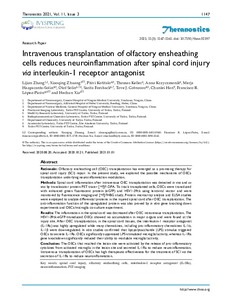Intravenous transplantation of olfactory ensheathing cells reduces neuroinflammation after spinal cord injury via interleukin-1 receptor antagonist
Han Chunlei; Kotitalo Päivi; Grönroos Tove J; Haaparanta-Solin Merja; Keller Thomas; Zhuang Xiaoqing; Solin Olof; Krzyczmonik Anna; Xia Hechun; Forsback Sarita; López-Picón Francisco R; Zhang Lijian
Intravenous transplantation of olfactory ensheathing cells reduces neuroinflammation after spinal cord injury via interleukin-1 receptor antagonist
Han Chunlei
Kotitalo Päivi
Grönroos Tove J
Haaparanta-Solin Merja
Keller Thomas
Zhuang Xiaoqing
Solin Olof
Krzyczmonik Anna
Xia Hechun
Forsback Sarita
López-Picón Francisco R
Zhang Lijian
IVYSPRING INT PUBL
Julkaisun pysyvä osoite on:
https://urn.fi/URN:NBN:fi-fe2021042820945
https://urn.fi/URN:NBN:fi-fe2021042820945
Tiivistelmä
Rationale: Olfactory ensheathing cell (OEC) transplantation has emerged as a promising therapy for spinal cord injury (SCI) repair. In the present study, we explored the possible mechanisms of OECs transplantation underlying neuroinflammation modulation.Methods: Spinal cord inflammation after intravenous OEC transplantation was detected in vivo and ex vivo by translocator protein PET tracer [F-18]F-DPA. To track transplanted cells, OECs were transduced with enhanced green fluorescent protein (eGFP) and HSV1-39tk using lentiviral vector and were monitored by fluorescence imaging and [F-18]FHBG study. Protein microarray analysis and ELISA studies were employed to analyze differential proteins in the injured spinal cord after OEC transplantation. The anti-inflammation function of the upregulated protein was also proved by in vitro gene knocking down experiments and OECs/microglia co-culture experiment.Results: The inflammation in the spinal cord was decreased after OEC intravenous transplantation. The HSV1-39tk-eGFP-transduced OECs showed no accumulation in major organs and were found at the injury site. After OEC transplantation, in the spinal cord tissues, the interleukin-1 receptor antagonist (IL-1Ra) was highly upregulated while many chemokines, including pro-inflammatory chemokines IL-1 alpha, IL-1 beta were downregulated. In vitro studies confirmed that lipopolysaccharide (LPS) stimulus triggered OECs to secrete IL-1Ra. OECs significantly suppressed LPS-stimulated microglial activity, whereas IL-1Ra gene knockdown significantly reduced their ability to modulate microglial activity.Conclusion: The OECs that reached the lesion site were activated by the release of pro-inflammatory cytokines from activated microglia in the lesion site and secreted IL-1Ra to reduce neuroinflammation. Intravenous transplantation of OECs has high therapeutic effectiveness for the treatment of SCI via the secretion of IL-1Ra to reduce neuroinflammation.
Kokoelmat
- Rinnakkaistallenteet [19207]
